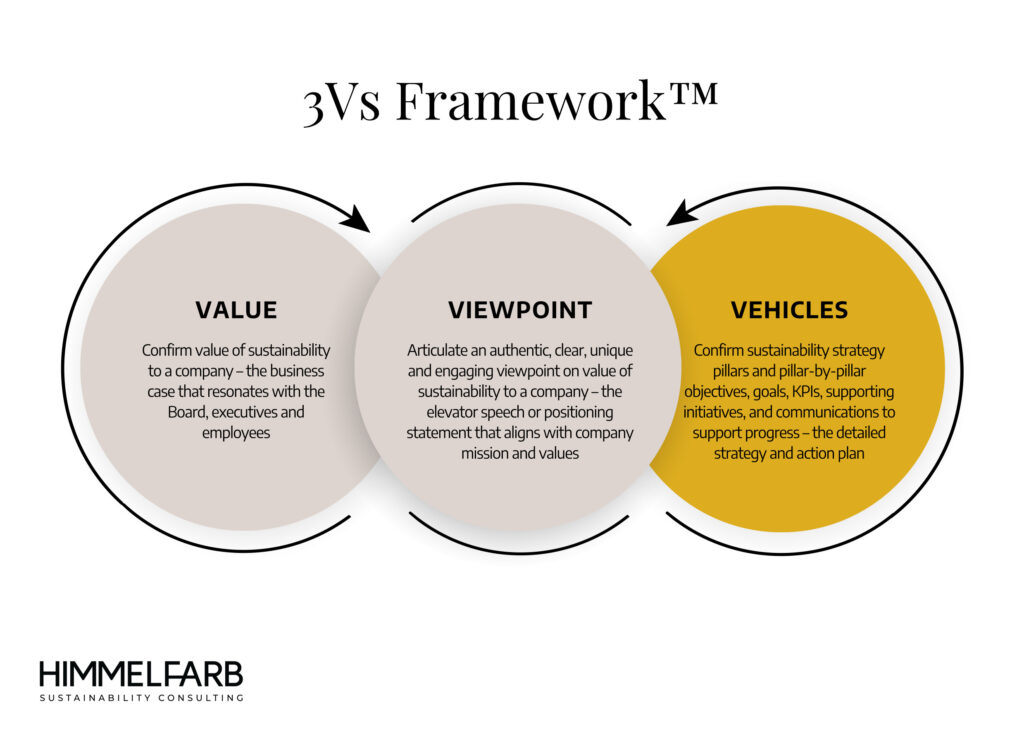
3Vs Framework™: Guidance on Sustainability Communications
My 3Vs Framework™ provides a helpful roadmap for businesses to develop and execute an effective sustainability strategy.

Years ago, pop star Justin Bieber asked the question, “What do you mean?” Customers, consumers, and employees ask the same question when they see and hear corporate sustainability communications that are generic and uncompelling or misleading and incomplete.
Confusion means that businesses are not communicating effectively on sustainability. Effective communications are key to implementing a sustainability strategy, which is why they are included in the third V (Vehicles) of my 3Vs Framework™.
Here is guidance on sustainability communications. (If you want guidance on the other aspects of my 3Vs Framework™, please contact me or read my blog on sustainability viewpoint.)
Consider multiple audiences
To create trust, communications must consider all of your company’s key stakeholders. Engage every audience to build trust, by addressing their priorities and interests. Some might look for a formal sustainability report, while others look for product labels. In each case, make sure that your company’s underlying sustainability viewpoint is consistent and visible.
Move beyond certifications
If your company’s products are third-party certified for sustainability, as is the case with McDonald’s fish products, for example, consumers should hear this. However, you cannot rely exclusively on certification and related ecolabels as the vehicle to talk about sustainability. Third-party certification serves as back-up support, with people still needing to hear your company’s “why” — why sustainability matters to the company and how the certification supports that.
Be creative
Good communicators succeed in bringing their sustainability viewpoint to life. They often show more than they tell. Who wouldn’t prefer to watch engaging videos and use apps about Chipotle’s new responsible restaurant design or becoming part of nature again, instead of reading the text of the company’s sourcing requirements? Videos and apps are also more memorable and invite conversation with the company, friends, family, etc.
Years ago, Green Mountain Coffee launched a dynamic campaign that showcased its coffee as being “[b]etter quality coffee for you; better quality life for farmers.” They used language that consumers could understand better than “fair trade,” which succeeded in showcasing their products’ Fair Trade Certified label and the company’s overall sustainability viewpoint.
Communicate often
Look for opportunities to repeat your sustainability messages over and over to create and reinforce emotional connections with your company’s brands and products. There are many options, beyond your company’s website. Consider social media campaigns, byline placements in online and print media, speaking engagements, on-pack messaging, sustainability reports, partnerships with NGOs, appropriate ecolabels and employee volunteerism.
Tell all the facts
Everyone expects complete and truthful information – about your company’s sustainability goals, progress, challenges, and unknowns. Telling an incomplete story or an ambiguous story only breeds confusion and mistrust, leaving openings for competitors, activists and investigative media to fill in and clarify the gaps.
Questions to Ask Yourself
Try asking these key questions to determine which communications are most effective:
- Will your communications reduce confusion on sustainability? Have you provided enough specifics?
- Will your communications inspire employees and consumers, in particular, to feel emotionally connected to your company and products? Are you telling memorable, sharable stories that bring sustainability to life?
- Will your communications resonate with all of your key stakeholders? Have you included multiple touch points to engage customers, consumers, investors, employees, bloggers, NGOs, regulators, etc.?
- Have you engaged your employees to serve as ambassadors for your company and your company’s sustainability viewpoint? Do they believe and trust that you’re walking the talk?
- Do you have a strategy for ongoing, continuous engagement on your company’s sustainability viewpoint? Are you inviting two-way conversation?
- Have you paid attention to product labels? Will your on-pack sustainability messages help consumers make purchase decisions? Did you consider an appropriate ecolabel, and are you relying on it appropriately?
- Is the sustainability content on your website readable, well-organized, and aggressively edited to eliminate forgettable, unnecessary text?
- Do you have a management approach for fulfilling your sustainability commitments? Are you prepared to explain any unknowns or shortfalls in your sustainability performance?
- Are you being completely transparent and truthful?
- Avoiding greenwashing: Have you told all the facts, including the unknowns and shortfalls, regarding your sustainability performance?
- Avoiding green hushing: Are you telling enough, or hiding details and successes because fear opening the company up to questions?
You know that sustainability is good for your business. Now ensure you have effective sustainability communications to disclose your company’s performance, celebrate progress, and connect with your stakeholders.
Updated and adapted from articles previously written by Nancy Himmelfarb and published by GreenBiz (now Trellis) and 3BL Media; and Nancy’s workshop for members of Illinois Manufacturing Excellence Center.
designed by social circle
privacy policy
follow me on LinkedIn
info@himmelfarb.com
© 2024 himmelfarb sustainability consulting
share